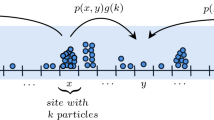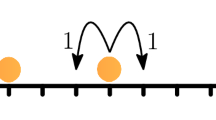Abstract
Low temperature analysis of nonequilibrium systems requires finding the states with the longest lifetime and that are most accessible from other states. We determine these dominant states for a one-dimensional diffusive lattice gas subject to exclusion and with nearest neighbor interaction. They do not correspond to lowest energy configurations even though the particle current tends to zero as the temperature reaches zero. That is because the dynamical activity that sets the effective time scale, also goes to zero with temperature. The result is a non-trivial asymptotic phase diagram, which crucially depends on the interaction coupling and the relative chemical potentials of the reservoirs.



Similar content being viewed by others
References
Beltrán, J., Landim, C.: Tunneling of the Kawasaki dynamics at low temperatures in two dimensions. J. Stat. Phys. 40, 1065–1114 (2010)
Bollobas, B.: Modern Graph Theory. Springer, Berlin (1998)
Bovier, A., den Hollander, F., Spitoni, C.: Homogeneous nucleation for Glauber and Kawasaki dynamics in large volumes at low temperatures. Ann. Appl. Probab. 38, 661–713 (2010)
Bricmont, J., Kuroda, K., Lebowtiz, J.L.: First order phase transitions in lattice and continuous systems: extension of Pirogov-Sinai theory. Commun. Math. Phys. 101, 501–538 (1985)
Cancrini, N., Cesi, F., Martinelli, F.: The spectral gap for the Kawasaki dynamics at low temperature. J. Stat. Phys. 95, 215–271 (1999)
Derrida, B., Evans, M.R., Hakim, V., Pasquier, V.: Exact solution of a 1D asymmetric exclusion model using a matrix formulation. J. Phys. A, Math. Gen. 26, 1493–1517 (1993)
Derrida, B.: Non-equilibrium steady states: fluctuations and large deviations of the density and of the current. J. Stat. Mech. P07023 (2007)
De Smedt, G., Godrèche, C., Luck, J.M.: Metastable states of the Ising chain with Kawasaki dynamics. Eur. Phys. J. B 32, 215–225 (2003)
Dobrushin, R.L.: Existence of phase transitions in models of a lattice gas. In: Proc. Fifth Berkeley Sympos. Math. Statist. and Prob., vol. 3, pp. 73–87. Univ. of Calif. Press, Berkeley (1966)
Griffiths, R.B.: Rigorous results and theorems. In: Domb, C., Green, M.S. (eds.) Exact Results. Phase Transitions and Critical Phenomena, vol. 1 (1972)
Slawny, J.: In: Domb, C., Lebowitz, J.L. (eds.) Low-Temperature Properties of Classical Lattice Systems: Phase Transitions and Phase Diagrams, vol. 11 (1987)
Gois, B., Landim, C.: Zero-temperature limit of the Kawasaki dynamics for the Ising lattice gas in a large two-dimensional torus. arXiv:1305.4542
den Hollander, F., Nardi, F.R., Troiani, A.: Kawasaki dynamics with two types of particles: stable/metastable configurations and communication heights. J. Stat. Phys. 145, 1423–1457 (2011)
Kawasaki, K.: Diffusion constants near the critical point for time-dependent Ising models. Phys. Rev. 145, 224–230 (1966)
Kolomeisky, A.B., Schütz, G.M., Kolomeisky, E.B., Straley, J.P.: Phase diagram of one-dimensional driven lattice gases with open boundaries. J. Phys. A, Math. Gen. 31, 6911–6919 (1998)
Maes, C., Netočný, K.: Heat bounds and the blowtorch theorem. Ann. Henri Poincaré November, 1–10 (2012)
Miekisz, J.: Evolutionary game theory and population dynamics. In: Capasso, V., Lachowicz, M. (eds.) Multiscale Problems in the Life Sciences, from Microscopic to Macroscopic. Lecture Notes in Mathematics, vol. 269, p. 316 (2008)
Miekisz, J.: Private Communication
Miekisz, J.: Stochastic stability in spatial games. J. Stat. Phys. 117, 99110 (2004)
Minlos, R.A., Sinai, Ya.G.: New results on the phase transitions of the 1st kind in lattice gas models. In: Tr. Mosk. Mat. Obs., vol. 17, pp. 213–242. Moscow State University, Moscow (1967)
Pirogov, S., Sinai, Ya.: Phase diagrams of classical lattice systems. Theor. Math. Phys. 25, 1185–1192 (1975) and 26, 39–49 (1976)
Privman, V. (ed.): Nonequilibrium Statistical Mechanics in One Dimension. Cambridge University Press, Cambridge (1997)
Shubert, B.: A flow-graph formula for the stationary distribution of a Markov chain. IEEE Trans. Syst. Man Cybern. 5, 565 (1975)
Sinai, Ya.: Theory of Phase Transitions, 1st edn. Pergamon, Elmsford (1982)
Schmittmann, B., Zia, R.K.P.: In: Domb, C., Lebowitz, J. (eds.) Phase Transitions and Critical Phenomena, vol. 17. Academic Press, London (1995)
Schütz, G.M.: Exactly solvable models for many-body systems far from equilibrium. Phase Transit. Crit. Phenom. 19, 1–251 (2001)
Acknowledgements
We very much thank Karel Netočný for the many discussions on this topic. In particular, WOKdG is grateful for the hospitality at the Institute of Physics, Academy of Sciences in Prague. We would also like to thank Jacek Miekisz for sharing his alternative and more direct proof of Theorem 6.1. We are also grateful to two referees for numerous improvements.
Author information
Authors and Affiliations
Corresponding author
Appendices
Appendix A: Kirchhoff Formula
A useful representation of the stationary distribution is in terms of the Kirchhoff formula [2, 17, 19] and [23]
in which the last sum runs over all spanning trees in the graph \(\mathcal{G}\) and \(\mathcal{T}_{x}\) denotes the in-tree to x defined for any tree \(\mathcal{T}\) and state x by orienting every edge in \(\mathcal{T}\) towards x; its weight \(w(\mathcal{T}_{x})\) is
i.e., the product of transition rates k(b)=k(y,z) over all oriented edges b≡(y,z) in the in-tree \(\mathcal{T}_{x}\). (To simplify notation, we identify the graph (see Fig. 4) with the set of its edges. We refer to [2] for the necessary elements of graph theory.)
Appendix B: Matrix Calculation
One can easily check from DE=D+E−ED that for all n≥0
for positive coefficients c ik . Similarly for m≥0
for positive coefficients f ik . Therefore,
where the third equality follows from retaining only the lowest order terms in (27), (28).
Rights and permissions
About this article
Cite this article
Maes, C., O’Kelly de Galway, W. A Low Temperature Analysis of the Boundary Driven Kawasaki Process. J Stat Phys 153, 991–1007 (2013). https://doi.org/10.1007/s10955-013-0878-6
Received:
Accepted:
Published:
Issue Date:
DOI: https://doi.org/10.1007/s10955-013-0878-6





